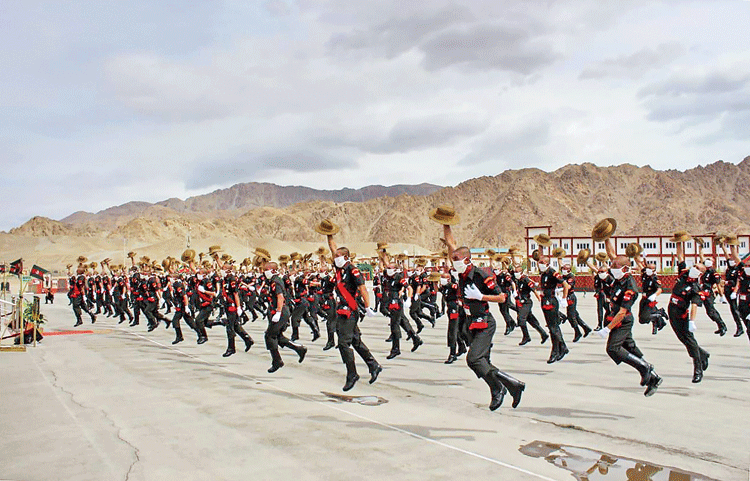India suffered heavy casualties and at least five Chinese soldiers have been killed in a series of brutal skirmishes in Ladakh’s Galwan Valley. No shots were fired in the bloody hand-to-hand clashes in which the Indian army said soldiers attacked each other with sticks and stones and an Indian colonel also died.
Up to 20 Indian soldiers may have been killed according to breaking news late in the evening in the lethal brawls, which are said to have gone on for several hours and which have caused shockwaves in India and China.
No deaths have taken place since 1975 on the borders between the two countries even when tensions were high such as during the 73-day Doklam crisis. The Chinese have accused India of launching the attack in the Galwan Valley. India has insisted that is has not launched any attacks.
Indian and Chinese major-general-level commanders met at a location called PP14 (Patrolling Point 14) at 7.45am near where the clashes took place to defuse the heated situation and China’s foreign ministry spokesman blamed aggressive behaviour by Indian soldiers, accusing them of crossing over into Chinese territory and thus causing the deadly clash. The Chinese spokesman warned that India should not take “unilateral action”.
An Indian Army statement said: “During the de-escalation process underway in the Galwan Valley, a violent face-off took place yesterday night with casualties on both sides.”
India says the encounter took place in the Galwan Valley, which it insists it has always controlled and which it says is not disputed territory. The Galwan Valley is one of three areas where Chinese soldiers moved into in big numbers during recent weeks and it is strategically important because it is near the vital road between Darbuk and Shyok to Daulat Beg Oldie, the world’s highest landing ground, which has been renovated in recent years by the Indian Air Force. The Galwan Valley is also strategically important and holding it could give it an advantage in regions like Pangong La.
The clashes took place a week after lieutenant general-level talks on June 6. Soon afterwards, both sides had spoken about de-escalation which appears not to have taken place.
Late in the evening the Ministry of External Affairs issued a statement which stressed that in the wake of a senior commander meeting the ground commanders had held a “series of meetings to implement the consensus reached at a higher level.” The MEA statement added: “While it was our expectation that this would unfold smoothly the Chinese side departed from the consensus to respect the Line of Actual Control (LAC) in the Galwan Valley.”
China accused India of violating the agreed status quo and attacking Chinese soldiers. “What is shocking is that on June 15, the Indian side severely violated our consensus and twice crossed the border line and provoked and attacked the Chinese forces, causing a violent physical confrontation between the two border forces,” Zhao Lijian, China’s foreign ministry spokesman, said at an afternoon press conference. He added: “China is raising strong opposition and stern representations to the Indian side on this.”
India initially announced three casualties, including one officer. The colonel who was killed was from the Bihar Regiment. One jawan who was killed is reported to have been from an artillery regiment.
China’s state-run Global Times, however, indicated there had been casualties on its side also. The Global Times’ editor Hu Xijn tweeted: “Chinese side also suffered casualties in the Galwan Valley physical clash.”
Hu also threw in a stern warning, saying: “I want to tell the Indian side, ‘Don’t be arrogant and misread China’s restraint as being weak. China doesn’t want to have a clash with India but we don’t fear it.’”
The Global Times quoted the People’s Liberation Army (PLA), Western Theatre Command, as saying: “Indian troops again crossed the Line of Actual Control (LAC) in the Galwan Valley region and purposefully launched provocative attacks, leading to severe clashes and casualties.” India insists it has always held the Galwan Valley region where the clashes took place.
During the afternoon, defence minister Rajnath Singh held two meetings with the army chief and the Chief of Defence Staff at which foreign minister S. Jaishankar was also present but did not issue a statement till the late evening. Singh later briefed the Prime Minister about the situation on the ground.
The Chinese, in recent weeks, infiltrated into areas close to PP14 in the Galwan Valley Sector and also at the Pangong Lake Sector where they appear to have moved from an area called Finger 4 to Finger 8 of the Pangong Lake. India has held the Galwan Valley but the Chinese have not accepted India’s claims to the area.
Analysts say that India is faced with tough choices now. It may have to accept the altered reality on the ground. Alternatively, it could raise the stakes by attempting to seize Chinese-held territory which might then be bartered for the areas now seized by the Chinese. This would obviously be a very drastic option that could have far-reaching consequences.
The last fatalities in clashes on the border between India took place in 1975 when Assam Rifles soldiers were ambushed by PLA soldiers at Tulung La in Arunachal Pradesh. In 1967, heavy fighting claimed lives on both sides but China is said to have been taken aback by the tough resistance it faced.
Indian analysts say that the Chinese have reacted strongly to India’s road-building in the region which would enable it to move troops more quickly into the area. China has been building roads in the easier Tibetan Plateau area. The Daily Telegraph has reported that there are now 12,000 Chinese troops stationed in Ladakh.











